- About Us
- Columns
- Letters
- Cartoons
- The Udder Limits
- Archives
- Ezy Reading Archive
- 2024 Cud Archives
- 2023 Cud Archives
- 2022 Cud Archives
- 2021 Cud Archives
- 2020 Cud Archives
- 2015-2019
- 2010-2014
- 2004-2009
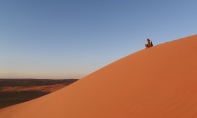 |
Postcard From Africa: |
The name Wilfred has been the cause of much explanation over the years – not least when traveling. In an often futile attempt to offer some familiarity, I have tried to list other Wilfreds: Wilfred Owen - the poet, Wilfred Burchett - the journalist, Wilfred Fullagar - the judge, and more recently Wilfred - … the dog.
Another Wilfred that I will now add to the list is Wilfred Thesiger – the enigmatic British adventurer who travelled by foot, mule and camel with Bedouins, and was the first European to explore much of the Arabian Peninsula in the 1940s. (Whether this addition to the list prompts any greater recognition of the name remains to be seen – though unlikely I suspect).
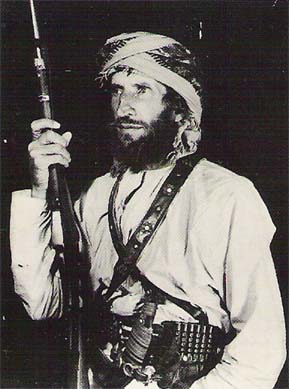
Wilfred Thesiger
Aside from exploring the Rub Al Khali – The Empty Quarter of the Arabian Peninsula (which, reflecting on its name, may not be that great an achievement), Thesiger also walked much of the Sultanate of Oman. He was by no means the first European to do so as the Portuguese had occupied the capital – Muscat – during the 1500’s, but arriving in Oman in January 2012 we realised that it wasn’t a well trodden path for westerners, nor a familiar one for us.
Before booking the flights into Muscat from Dubai, I couldn’t have placed Oman on a map of the world. Our categorical western clichés of the Arab world were all I had to prepare me for the east coast of the Arabian Peninsula, moderated (perhaps reinforced) by viewing the Lawrence of Arabia on an Emirates flight a few weeks previously (one for any Lawrences compiling a similar list of famous namesakes …).
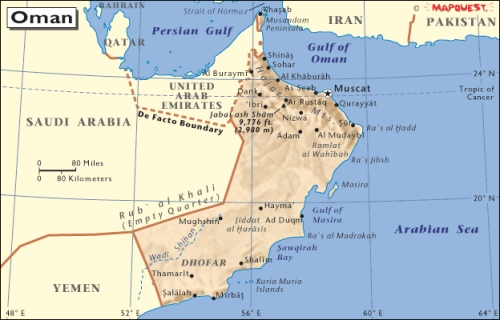
Oman … placed on a map
(Source: HRW World Atlas)
While the sand, camels and petroleum production should be reasonably unthreatening to someone from the Australian continent, I arrived in the sultanate (wondering what a sultanate was), uncertain about burquas and dish dashes (and other loose, anonymous clothing), confounded by the Arabic language and alphabet (words and place names such as Rub Al Khali written above, blended meaninglessly to me, for want of any familiarity), suspecting it might be difficult to have a beer and hoping that my unease was just the result of ignorance and the phobias developed from Hollywood’s war on terror.
Added to which, now that I could place Oman on a map of the world, it became apparent that the Islamic Republic of Iran (now wondering what an Islamic Republic was) was only a few hundred kilometres away – across the Sea of Oman … and surely that wasn’t a good thing … . In fact, the spectacular fjords of Musandam (a separate territory of Oman, nestled among the United Arab Emirates – see above) form the southern border of the Strait of Hormuz – which Iran is threatening to block, stranding oil tankers from the Persian Gulf.
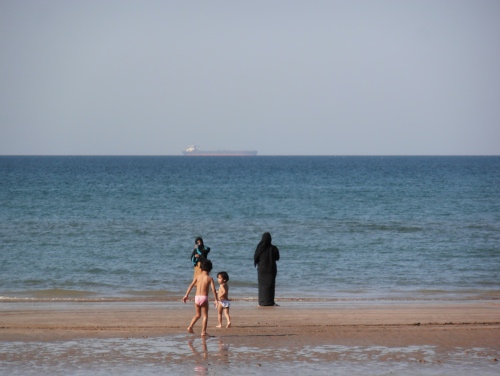
Heading to the beach on the Sea of Oman
However after effortlessly receiving a visa at the airport, withdrawing Omani Real from an ATM, taking a taxi along perfect roads to beach-front accommodation (German-run, of course), swimming ‘modestly’ (particularly for women) in the Sea of Oman, eating a dinner of wonderful fresh food in beautiful courtyards (without a beer), and enjoying warm greetings and assistance at every turn, my unfounded concerns (read: prejudices) faded.
The historic city of Muscat was a beautiful setting for our first night in the ‘Arab World.’ The fascinating blend of ages – subsistence fishing that had grown into unwittingly netting turtles and manta rays from power boats; a resources boom that had produced beautifully modest buildings such as the Royal Opera House – rather than the sky-scraping hubris of Dubai; traditions of trade at souks (labyrinth market places) that still offered spices, garments, jewelry and raw materials – but no longer the slave trade that had seen the Omani palace relocated to Zanzibar in 1837.
However beyond the beauty of the architecture and the hospitality, the real breath-taking wonder of Oman appeared during a thousand kilometre road trip through the jagged, cloud rimmed Al Hajar Mountains (Arabic for stone mountains) into the desert interior. Heading away from the coast, we threaded our way through desiccated landscapes of sand and rock, sweeping dunes, lifeless plains, sheer cliffs of crumbling rock, and arrived in Nazwi – the former capital, known as the pearl of Islam and home to mosques dating back to the birth of the religion in the 7th century.
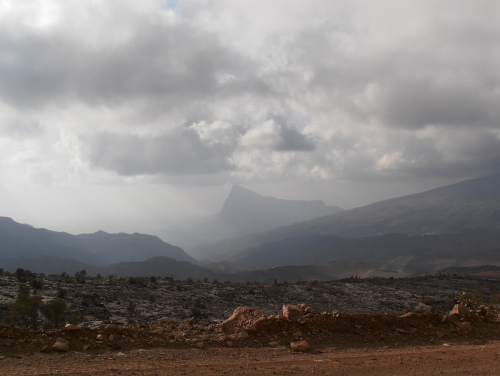
Jabal shams (Mountain of the Sun) – Oman’s highest peak in the Al Hajar Mountains
Leaving the relative modernity of our hotel in Nazwi (and our under-powered hire car), the next day we joined two other tourists (Germans, of course) in the back of a Landcruiser and slide quietly into the desert. For the next 24 hours we lost ourselves in the shifting silence of the desert, drank tea and ate dates with Bedouin groups, rode camels, watched the sun set over undulating contours of sand and retired to sleep in rugs as the temperatures fell away from our solitary open fire.
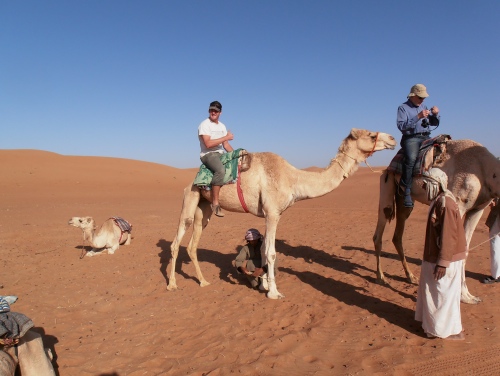
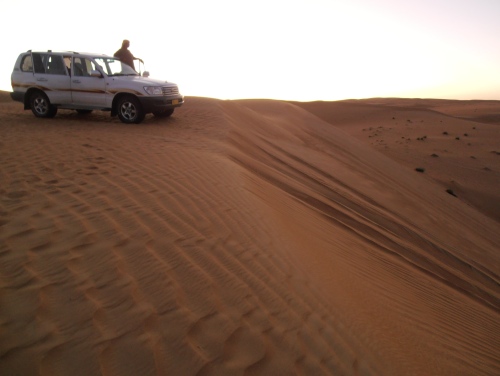
Contrasting ships of the desert
Returning from raw elements of desert life, our passage back to Muscat became more lush and fertile – bumbling eventually to the Wadi Bani Khalid. Until this point, wadis had been something of a mystery to me (unsurprisingly, as everything else in the country had been too) – marked on maps with symbols that suggested either swamps or palm tree-fringed golf courses. When we finally arrived at the famed wadi, it was a remarkable oasis of water in the desert – a trickle, becoming a pool, becoming an afternoon swim in a gorge, in the middle of one of the driest places we’d ever ventured. Dotted throughout Oman’s dramatic coastal range, these wadis (often ephemeral water-ways) provided a lush contrast to the parched mountains that they drained.
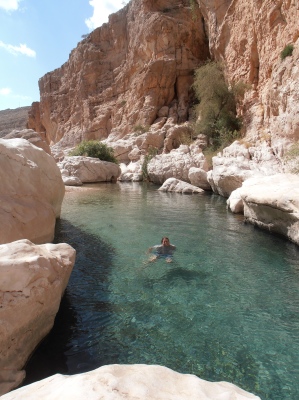
Bathing modestly in the Wadi Bani Khalid
By our fourth day in Oman we had learned Arabic numbers by counting down road signs, filled the tank of our hire car for less than the cost of a packet of chips, deciphered menus, relished the hospitality of locals and even picked up a hitch-hiker. The roadside figure stranded by his car with white gown billowing in the breeze would not be your average candidate for the empty backseat … until this enlightening trip to Oman at least.
Back to the coast, the stunning escarpment (and wadis) was almost matched in grandeur by the monumental motorways that radiated from Muscat. They led us back into the heart of early evening, commercial traffic, that organic form of driving that breaks all the rules, but is somehow safer and seemingly more efficient.

Off the coastal highway into the beautiful Wadi Tiwi
On our final night in Oman, all sense of discomfort and unease was long-forgotten, if anything I felt embarrassed to have arrived with such unhelpful stereotypes. Perhaps ‘we’ (the English-speaking, Christian world) will grow more familiar with Oman and the Arabian Peninsula, and perhaps ‘our’ uncertainty is understandable, as it is only 70 years since Wilfred Thesiger wandered into it – nothing like the history of relations with other countries, peoples … colonies. The points of contact (that started for me by enthusing about a namesake) will surely increase now, and Oman, its mountains, wadis, deserts and people will become more recognizable to me. As we left Oman behind, our desert footprints would already have blown into something else – a constantly changing landscape to some extent, but also a wonderful country for its constancy.
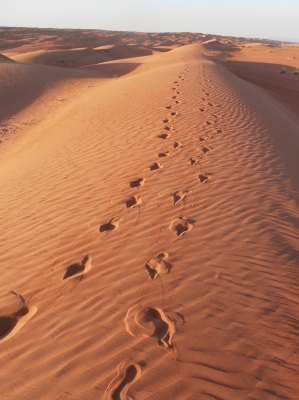
Our footsteps mirroring Thesiger’s
